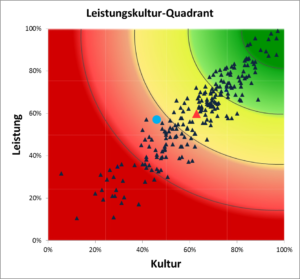Interplay of performance and culture
It is also very revealing that our analyses revealed a very high correlation between all factors. Accordingly, companies that are either based only on hard factors (goals, strategy, results, etc.) or only on soft performance culture aspects (employee orientation, constructive cooperation, etc.) do not have a real performance culture. Our study shows that only the combination of all hard factors (performance) and soft factors (culture) constitutes a true performance culture.
Why the six factors and thus hard and soft factors are inextricably linked can be easily understood with two examples:
A company had very motivated employees thanks to “constructive cooperation” and a “high level of employee orientation”. However, due to a lack of a clearly communicated corporate strategy (strategy and expectation clarity), the company’s financial goals could not be achieved, as the employees acted in completely different directions. The energy and motivation of the employees came to nothing.
Another example: A company had gone through a strategy process, and a strategic reorientation was decided and carefully communicated (strategy and expectation clarity was thus given). The goals of the departments and employees were aligned with the new strategy and pursued very consistently by top management (success orientation). Nevertheless, the strategically well-considered change of course did not lead to an increase in the monetary success of the company in the envisaged period. The reasons: Firstly, there was a lack of “constructive cooperation” during implementation, and secondly, there was a lack of sufficient trust in middle management to take on the necessary responsibility for implementation (responsibility and trust). Middle management, on the other hand, even seemed to block the change process in some places.
The fact that “hard” aspects (performance) and “soft” aspects (culture) seem to be inextricably linked is also shown by the overview of results for all 230 companies that took part in the study.

1 Top performance culture*
2 Good performance culture*
3 Approaches to performance culture*
4 Performance culture deficiencies*
5 Pronounced performance culture deficit*
Example company (self-assessment): Culture 49 % Performance 52 % (blue circle)
Average of all companies: Culture 63 % Performance 60 % (red triangle)
Values of all companies (black triangles)
Do you have any questions?
Contact us!
